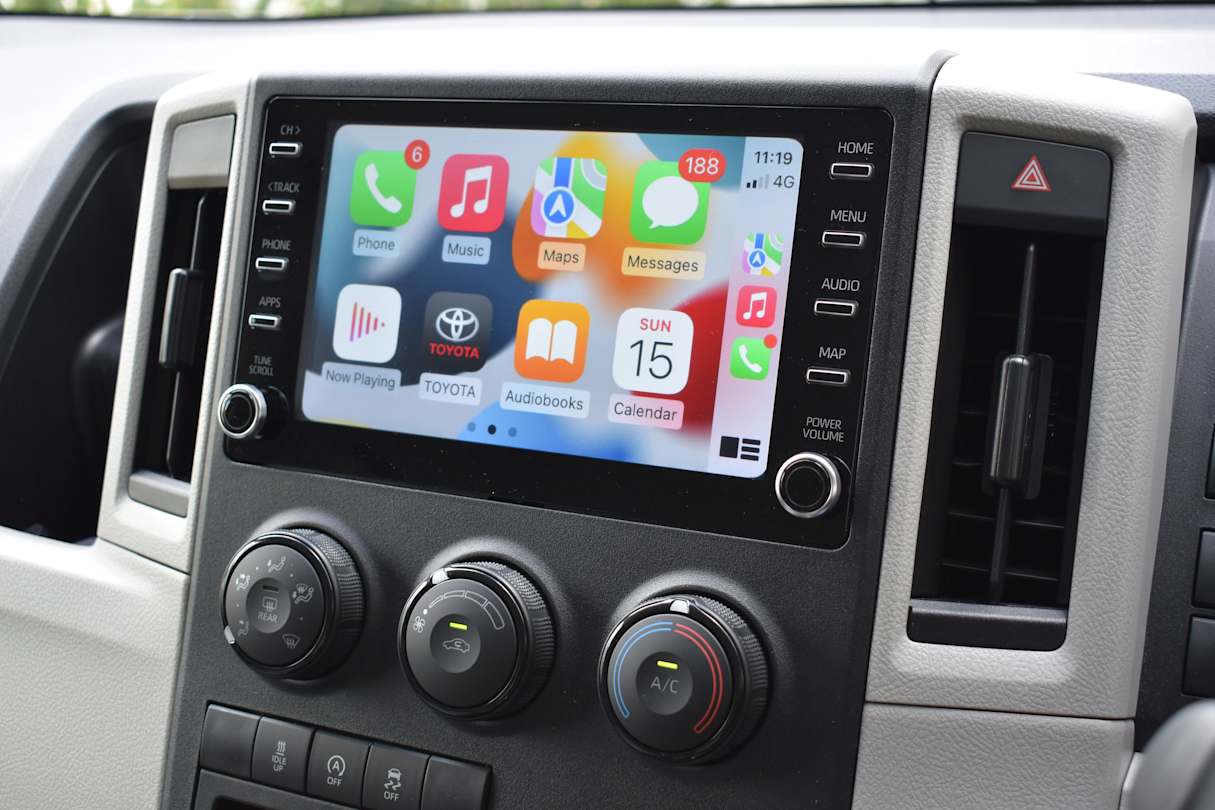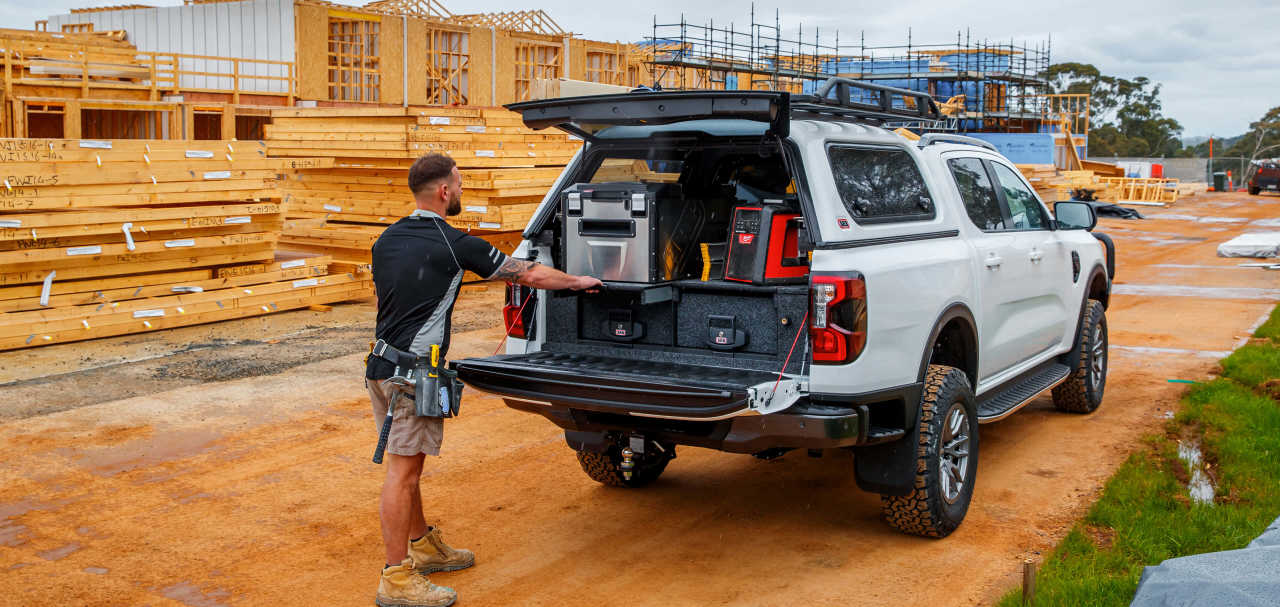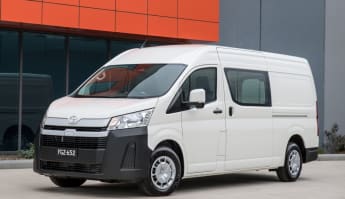Latest VFACTS new vehicle registration figures show that in 2024 the Toyota HiAce one-tonne van commands more than 46 per cent of the 2.5 to 3.5-tonne GVM segment.
In other words, almost every second new mid-sized van sold in Australia is a HiAce, leaving numerous competitors from Korean, European and Chinese manufacturers to fight over the remaining buyers.
So, why does the only Japanese competitor in this crowded space maintain such dominance? We recently became reacquainted with this venerable workhorse in search of answers.
Toyota Hiace 2024: LWB (4 Door) Barn Door
| Engine Type | Diesel Turbo 4, 2.8L |
|---|---|
| Fuel Type | Diesel |
| Fuel Efficiency | 8.2L/100km (combined) |
| Seating | 2 |
| Price From | $48,180 - $55,330 |
| Safety Rating |
|
Does it represent good value for the price? What features does it come with? 8/10
8 / 10
Our test vehicle is equipped with Toyota’s ubiquitous 2.8-litre four-cylinder turbo-diesel shared by all models in the HiAce range. However, ours is equipped with the optional six-speed automatic and rear barn doors which raises the list price to $51,636.
Even so, that’s still within the ballpark of its closest rivals including the LDV G10+ Barn Door ($40,063), Hyundai Staria Load Barn Door ($46,740), and Ford’s new Transit Trend LWB Barn Door ($57,590).

Our example is also equipped with a solid-walled left-side sliding door (in preference to the standard offering with window), which HiAce buyers can specify at no extra cost when ordering.
The two-seater HiAce comes standard with 'French Vanilla' paint and 16-inch steel wheels with replaceable plastic covers, 215/70R16 tyres and a full-size spare, but there’s no protective load-floor liner for the cargo bay (a Toyota genuine accessory is available).

There’s also halogen headlights and DRLs (no fancy LEDs here, folks) and the neat two-tone cabin has a tilt/reach adjustable leather-accented steering wheel, power-adjustable lumbar support on the driver’s seat, one USB port and two 12-volt cabin sockets, plus a large centre console that offers numerous storage options.
The driver also gets a 4.2-inch driver’s info display and there’s an 8.0-inch touchscreen (plus steering wheel switches) to control the two-speaker infotainment system, which offers multiple connectivity including Apple CarPlay/Android Auto, Bluetooth, digital radio and more.
Is there anything interesting about its design? 8/10
8 / 10
Toyota’s unwavering adherence to rear-wheel drive ensures the HiAce has an inherent traction advantage over its predominantly front-wheel-drive rivals, particularly when hauling heavy payloads on low-grip surfaces.
Rear-wheel drive also ensures the front wheels can be turned sharply enough for its 3210mm wheelbase to deliver an impressively tight 11.0-metre turning circle. And its 1990mm height also allows access to underground loading docks and multi-storey car parks.

The chassis design is simple and robust with MacPherson strut front suspension, a leaf-spring live rear axle, variable-ratio rack and pinion steering and (on automatic variants) four-wheel disc brakes.
There’s no mesh-type cargo barrier or solid bulkhead between the cargo bay and cabin (but both are also available as genuine accessories) and the black door-handles and unpainted black plastic front and rear bumpers are designed to best withstand the wear and tear often evident in these areas on hard-working vans.

The two-tone dash layout is neat and functional, with clear analogue instrumentation and dash controls (mostly physical dials and buttons) that are easy to reach and operate. And it sticks with a good old lever-type manual handbrake instead of an electric one. All are chosen for their rugged simplicity.
The only useful item missing is a fold-down inboard armrest for the driver’s seat, offered by numerous rivals to reduce neck and shoulder strain during long days behind the wheel.

How practical is its space and tech inside? 8/10
8 / 10
Our barn-door-equipped test vehicle has a hefty 2245kg kerb weight and 3300kg GVM, which results in a genuine one-tonne-plus payload rating of 1055kg. Up to 120kg of that weight can be carried on Toyota’s triple roof-rack set.
It’s also rated to tow up to 1500kg of braked trailer, which is less than some rivals but in reality should adequately cover most towing requirements of van operators.

And with its 4800kg GCM rating (or how much weight it can legally carry and tow at the same time), that means it can carry its maximum payload while towing its maximum trailer weight. So, that’s a combined total of more than 2.5 tonnes of cargo-carrying ability, which would comfortably meet or exceed most job requirements.
The generously-sized cargo bay, which offers an impressive 6.2 cubic metres of load volume, is accessed from either side through sliding doors with large 1010mm openings, or from the rear through the optional barn doors which can be opened to 180 degrees (with special lower hinges to hold them there) allowing easy access for forklifts.

The cargo bay is 2530mm long, 1760mm wide and 1340mm high and with 1268mm between the rear wheel housings it can swallow up to two standard Aussie pallets or up to three Euro pallets, held in place by a choice of six load-anchorage points.
There’s plenty of internal lighting, the walls and doors are lined to mid-height and the roof features a full-length internal lining, which is unusual for vans and we suspect contributes to suppression of tyre noise emanating from the rear wheel housings.

Cabin storage includes a large bottle holder and bin in the base of each front door, small-bottle/cupholders on either side of the dash and in the centre, plus a single glove box. The well-designed centre console offers another two bottle holders plus large internal storage, which is capped by a hinged lid that multi-tasks as a shallow storage tray and handy work desk.
What are the key stats for its engine and transmission? 8/10
8 / 10
Toyota’s well-proven 1GD-FTV 2.8 litre four-cylinder turbo-diesel, which also powers Toyota’s HiLux, Fortuna and Prado model lines, produces 130kW at 3400rpm and (in auto models like ours) 450Nm of torque between 1600-2400rpm. Its Euro 5 emissions compliance doesn’t require AdBlue, which minimises maintenance and running costs.
The refined and smooth-shifting six-speed torque converter automatic offers the choice of sequential manual shifting if required. Fuel efficiency is also optimised with full torque converter lock-up on fourth, fifth and sixth gears, along with overdrive on fifth and sixth being ideal for highway driving. The inherent traction advantage of rear-wheel drive is enhanced by an electronically controlled automatic limited-slip diff.

What is its fuel consumption? What is its driving range? 8/10
8 / 10
Toyota claims combined average consumption of 7.9L/100km for our test vehicle, but the dash readout was showing 11.0L/100km when we stopped to refuel after 270km of testing.
This was conducted with the engine’s auto start/stop function switched off and comprised a mix of city, suburban and highway driving, of which about one third was hauling a near-maximum payload.
Our own figure, calculated from actual fuel bowser and tripmeter readings, was higher again at 11.8, which still isn’t bad for a vehicle with a kerb weight exceeding 2.2 tonnes driven mostly in busy urban traffic and hauling almost one tonne during our test. So, based on our ‘real-world’ consumption figures, you could expect a driving range of around 600km from its 70-litre tank.
What’s it like to drive? 8/10
8 / 10
It’s easy for drivers of most shapes and sizes to find a comfortable driving position in the spacious cabin, given its height/reach adjustable steering wheel, large left footrest and supportive seating with power-adjustable lumbar support.
Although there’s a huge blind spot over the driver’s left shoulder created by the solid walls of the cargo bay, active driver aids including blind-spot monitoring, rear cross-traffic alert and rear-view camera minimise the potential hazards of changing lanes and reversing out of driveways into busy traffic.
Braking is reassuringly strong and the steering is responsive, with easy manoeuvrability thanks to the conspicuously tight turning circle and lightness of the variable-ratio steering at parking speeds.

The ride quality is reasonably supple when unladen or lightly loaded and, for a van without a bulkhead between the cabin and cargo bay, has comparatively low internal noise levels at speeds up to 80km/h.
The 2.8-litre turbo-diesel, with its sizeable 450Nm of torque, has strong low-rpm response and displays good flexibility in city and suburban driving.
Its performance is optimised by the smooth-shifting six-speed auto, which also delivers fuel-efficient highway travel that requires less than 2000rpm to maintain 110km/h. The sequential manual-shifting function can be handy in certain situations, like carrying/towing heavy loads in hilly terrain.

To test its GVM rating we forklifted 890kg into the cargo bay, which combined with the driver equalled a total payload of 990kg that was only 65kg shy of its 1055kg limit.
The stout rear leaf-springs only compressed about 30mm under this loading, which left more than 60mm of static bump-stop clearance that was more than enough to ensure there was no bottoming-out on our test route.
The turbo-diesel’s ample torque made light work of hauling this payload in city, suburban and highway driving. It was also particularly strong in the hills, where it easily conquered our 13 per cent gradient, 2.0km-long set climb in third gear.

Engine braking on the way down, in a manually selected second gear, wasn’t as strong but far from disgraced given the near one-tonne payload it was trying to restrain. Even so, its four-wheel disc brakes were more than capable of keeping speeds in check.
Our only criticism is the high internal noise levels at highway speeds, when tyre roar through the rear wheel housings can become intolerable over long distances, particularly on coarse bitumen surfaces with an empty cargo bay amplifying the noise.
In our experience, this is a problem shared by all vans at these speeds if they’re not equipped with a sealed cabin bulkhead. So, if your work involves a lot of highway travel, we would recommend fitting one that's available in Toyota’s genuine accessories range. Or buying some earplugs.
Warranty & Safety Rating
What safety equipment is fitted? What safety rating? 9/10
9 / 10
The HiAce has a five-star ANCAP rating awarded in 2019 which will expire in December 2025. It comes with seven airbags plus benchmark active safety features including AEB with pedestrian and daytime cyclist detection, lane departure alert with braking assist, speed sign recognition, blind-spot monitoring, rear cross-traffic alert, front and rear parking sensors, reversing camera and more.
What warranty is offered? What are its service intervals? What are its running costs? 7/10
7 / 10
It is covered by a five-year/unlimited km warranty. Scheduled servicing is a relatively short six months/10,000km intervals, whichever occurs first. Capped-price of $290 per service covers the first six scheduled services over three years or 60,000km.

Verdict
When you consider its competitive pricing (particularly for fleets), resolute resale value, robust construction, rock-solid reliability, excellent load-hauling ability, five-star safety and all-round practicality, it’s not hard to understand why the HiAce is such a popular workhorse. It’s not perfect, like any van, but when performing its intended role it’s very good.
Pricing Guides



.jpg)





.png)


.jpg)
.jpg)
.jpg)

.jpg)

